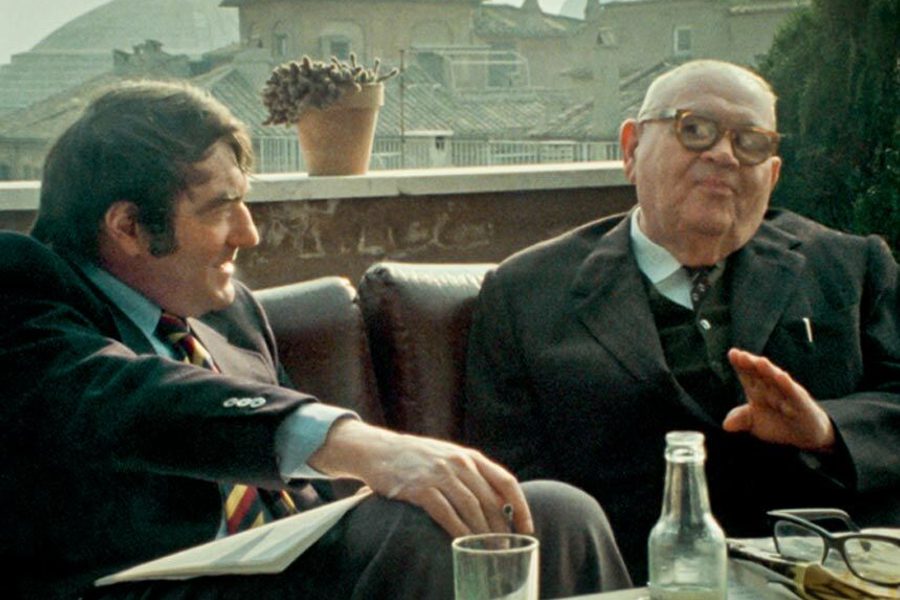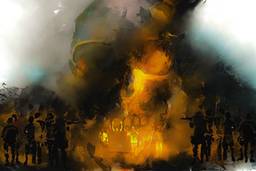Let the Witness Speak
In Claude Lanzmann’s new Holocaust documentary The Last of the Unjust, the line between right and wrong blurs.
Michael Atkinson

The Last of the Unjust, the newest addition to the Claude Lanzmann Living Museum of Holocaust Interrogation, caps a 40-year mission that began at a time when the idea of “witness,” as applied first to the Final Solution, had evolved into a critical cultural principle. Commissioned by the Israeli government in the early 1970s, Lanzmann, then an editor at Les Temps Modernes, began by filming long interviews with witnesses in 14 countries, a process that took six years and accumulated 350 hours of footage. That footage was edited down to the 1985 classic Shoah, Lanzmann’s 9.5-hour magnum opus. In the years since, Lanzmann has worked at shaping the “outtakes” into other films of their own, including the new 220-minute The Last of the Unjust, which picks over the history of Theresienstadt, the Nazis’ showcase concentration camp.
The focus is on Benjamin Murmelstein, a Viennese rabbi who, after the Anschluss, became an intermediary between Austrian Jews and Adolf Eichmann, and then, late in WWII, was installed as the Elder of the Jews at Theresienstadt after the two previous leaders had been shot. The loquacious Murmelstein survived to live out a rather ignominious and Israel-despised existence for decades in Italy, where Lanzmann found him. Famously, Theresienstadt was the Third Reich’s “model city” for relocated Jews, complete with its own orchestra and soccer tournaments, but as Murmelstein tells it, the camp’s public role was always a thin mask for atrocity, slavery and further deportations to Auschwitz. As the war inflicted pressure on the Nazis, the ruse collapsed completely, and Theresienstadt became just another mass of Jews waiting for disposal.
Thus Murmelstein’s dilemma was thrust upon him. Any functionary receiving orders from Adolf Eichmann was accused of collaboration, but Murmelstein went further than just taking orders — in order to preserve Theresienstadt’s threadbare profile as some kind of public institution, and therefore save its population to some degree, he manipulated the inmates, sequestered rations to force them to get typhus shots, and made them work a 70-hour week. Murmelstein’s desperate machinations fed multiple accusations after the war, and he’s lived his life in defensive antagonism ever since.
The Last of the Unjust fleshes out much of the Holocaust’s berserk paradigm, in particular the basic moral dilemma between resistance’s capacity for additional destruction and cooperation’s potential for saving lives. Murmelstein is relentlessly self-justifying, but you come away with the unarguable sense that the position in which the rabbi was put — the position in which every Jew was put — was essentially impossible, and cannot be dissected or assessed in an ordinary social context. Conclusions about survivors’ behavior should always be drawn with superhuman prudence.
To some degree, the force of The Last of the Unjust is delivered in spite of Lanzmann’s laxness as a filmmaker. You could certainly argue that the breadth and importance of his subject demands expansive cinematic real estate, but the new film, like all of Lanzmann’s oeuvre — even Shoah—suffers from repetition, unfruitful longueurs and self-indulgence. Murmelstein’s babbling-brook orations from 1975 stand as they should — as pure, unabridged witness. But a sizable percentage of the film features an aged Lanzmann himself slowly walking around Theresienstadt and its surrounding towns in the present day, recounting facts in an angry mumble. The gorgeous sunlit landscapes themselves, as in Alain Resnais’ Night and Fog (1955), emanate their own horrible irony. But Lanzmann’s brooding first-person presence is not only unnecessary, but inauthentic. He’s a secondhand witness, and how he feels about what he’s been told is inconsequential — and inconsequential at incredible length.
There are presumably hundreds of hours of testimony as yet unused waiting in Lanzmann’s archive, all of it by definition more historically pertinent than whatever Lanzmann is doing or thinking in 2013. But he is 88 now, and so perhaps their stewardship will pass to other hands. Either way, the story of the Holocaust — easily the most fraught and storied decade or so in human history — is far from finished being told.









